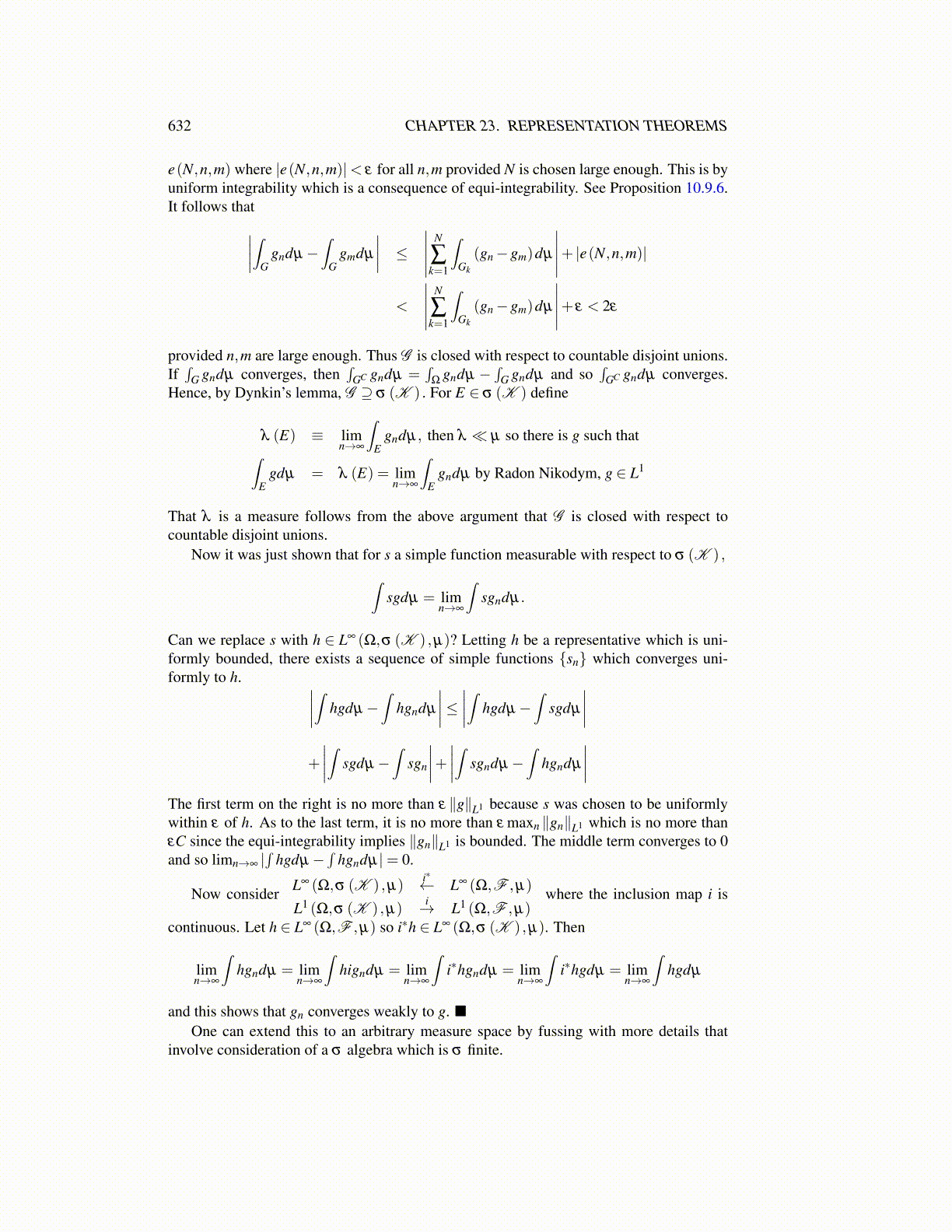
632 CHAPTER 23. REPRESENTATION THEOREMS
e(N,n,m) where |e(N,n,m)|< ε for all n,m provided N is chosen large enough. This is byuniform integrability which is a consequence of equi-integrability. See Proposition 10.9.6.It follows that∣∣∣∣∫G
gndµ−∫
Ggmdµ
∣∣∣∣ ≤∣∣∣∣∣ N
∑k=1
∫Gk
(gn−gm)dµ
∣∣∣∣∣+ |e(N,n,m)|
<
∣∣∣∣∣ N
∑k=1
∫Gk
(gn−gm)dµ
∣∣∣∣∣+ ε < 2ε
provided n,m are large enough. Thus G is closed with respect to countable disjoint unions.If∫
G gndµ converges, then∫
GC gndµ =∫
Ωgndµ −
∫G gndµ and so
∫GC gndµ converges.
Hence, by Dynkin’s lemma, G ⊇ σ (K ) . For E ∈ σ (K ) define
λ (E) ≡ limn→∞
∫E
gndµ, then λ ≪ µ so there is g such that∫E
gdµ = λ (E) = limn→∞
∫E
gndµ by Radon Nikodym, g ∈ L1
That λ is a measure follows from the above argument that G is closed with respect tocountable disjoint unions.
Now it was just shown that for s a simple function measurable with respect to σ (K ) ,∫sgdµ = lim
n→∞
∫sgndµ.
Can we replace s with h ∈ L∞ (Ω,σ (K ) ,µ)? Letting h be a representative which is uni-formly bounded, there exists a sequence of simple functions {sn} which converges uni-formly to h. ∣∣∣∣∫ hgdµ−
∫hgndµ
∣∣∣∣≤ ∣∣∣∣∫ hgdµ−∫
sgdµ
∣∣∣∣+
∣∣∣∣∫ sgdµ−∫
sgn
∣∣∣∣+ ∣∣∣∣∫ sgndµ−∫
hgndµ
∣∣∣∣The first term on the right is no more than ε ∥g∥L1 because s was chosen to be uniformlywithin ε of h. As to the last term, it is no more than ε maxn ∥gn∥L1 which is no more thanεC since the equi-integrability implies ∥gn∥L1 is bounded. The middle term converges to 0and so limn→∞ |
∫hgdµ−
∫hgndµ|= 0.
Now consider L∞ (Ω,σ (K ) ,µ)i∗← L∞ (Ω,F ,µ)
L1 (Ω,σ (K ) ,µ)i→ L1 (Ω,F ,µ)
where the inclusion map i is
continuous. Let h ∈ L∞ (Ω,F ,µ) so i∗h ∈ L∞ (Ω,σ (K ) ,µ). Then
limn→∞
∫hgndµ = lim
n→∞
∫higndµ = lim
n→∞
∫i∗hgndµ = lim
n→∞
∫i∗hgdµ = lim
n→∞
∫hgdµ
and this shows that gn converges weakly to g. ■One can extend this to an arbitrary measure space by fussing with more details that
involve consideration of a σ algebra which is σ finite.